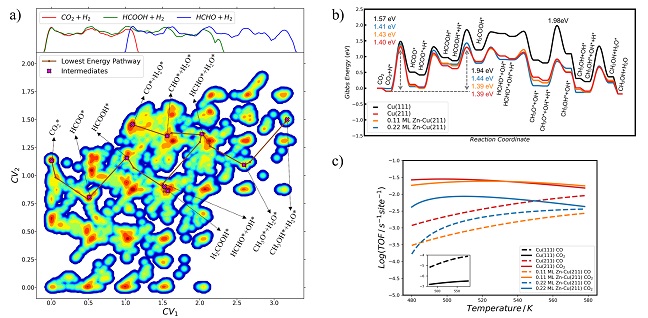Methanol synthesis on industrial Cu/ZnO/Al2O3 catalysts via the hydrogenation of CO and CO2 mixture, despite several decades of research, is still puzzling due to the nature of the active site and the role of CO2 in the feed gas. Herein, with the large-scale machine learning atomic simulation, we develop a microkinetics-guided machine learning pathway search to explore thousands of reaction pathways for CO2 and CO hydrogenations on thermodynamically favorable Cu–Zn surface structures, including Cu(111), Cu(211), and Zn-alloyed Cu(211) surfaces, from which the lowest energy pathways are identified. We find that Zn decorates at the step-edge at Cu(211) up to 0.22 ML under reaction conditions with the Zn–Zn dimeric sites being avoided. CO2 and CO hydrogenations occur exclusively at the step-edge of the (211) surface with up to 0.11 ML Zn coverage, where the low coverage of Zn (0.11 ML) does not much affect the reaction kinetics, but the higher coverages of Zn (0.22 ML) poison the catalyst. It is CO2 hydrogenation instead of CO hydrogenation that dominates methanol synthesis, agreeing with previous isotope experiments. While metallic steps are identified as the major active site, we show that the [−Zn–OH–Zn−] chains (cationic Zn) can grow on Cu(111) surfaces under reaction conditions, which suggests the critical role of CO in the mixed gas for reducing the cationic Zn and exposing metal sites for methanol synthesis. Our results provide a comprehensive picture on the dynamic coupling of the feed gas composition, the catalyst active site, and the reaction activity in this complex heterogeneous catalytic system.
https://pubs.acs.org/doi/abs/10.1021/jacs.2c06044

